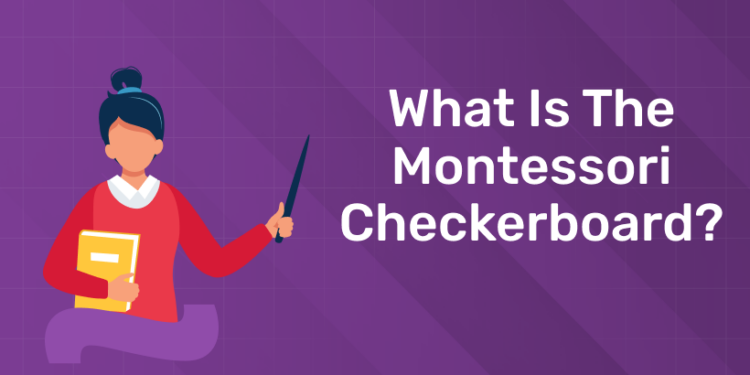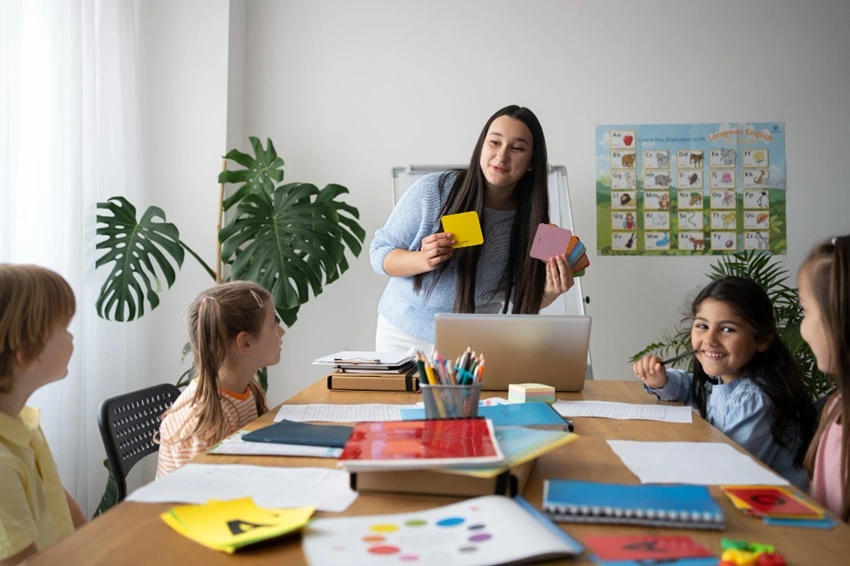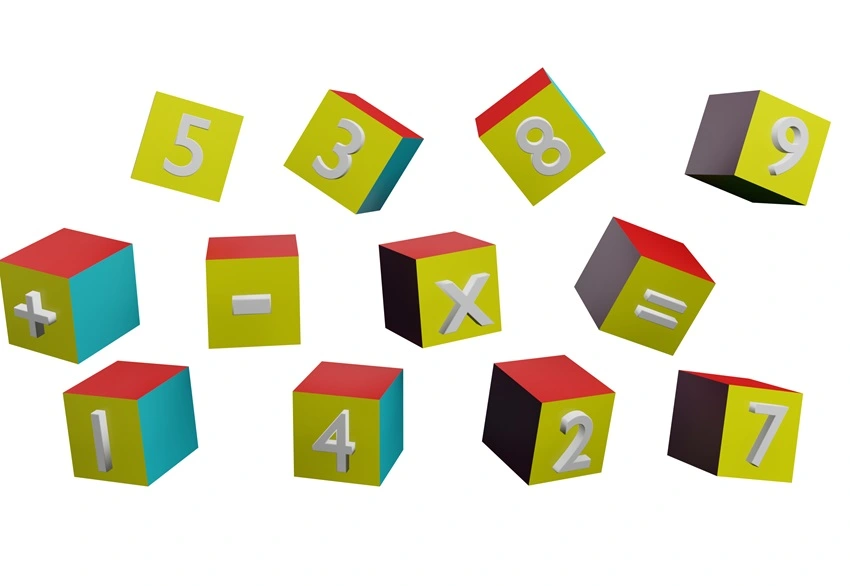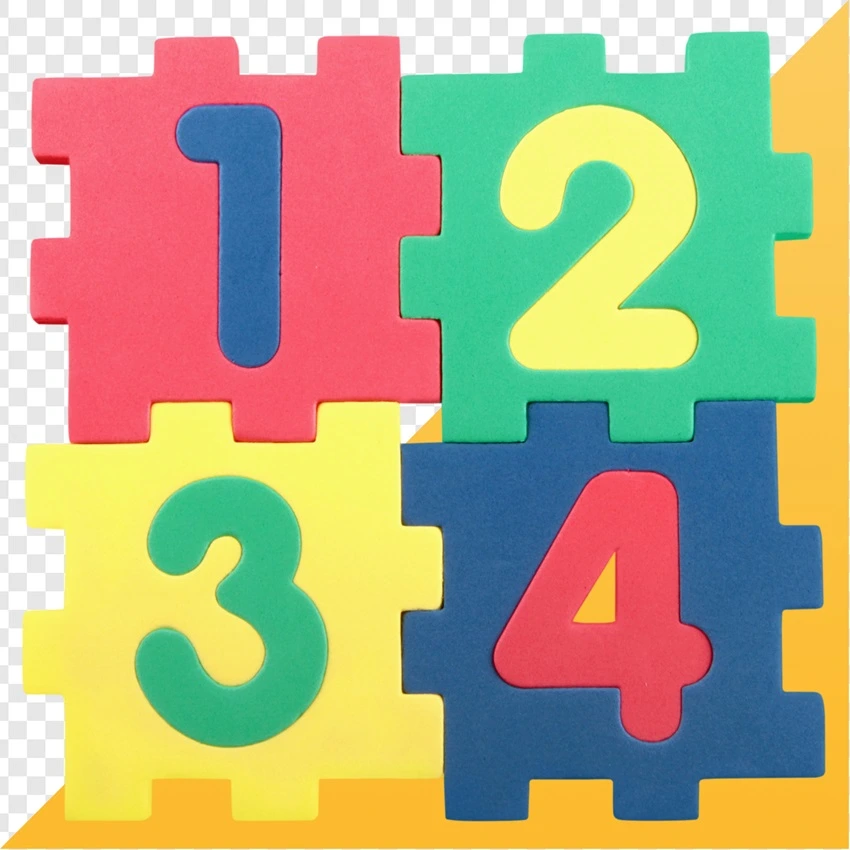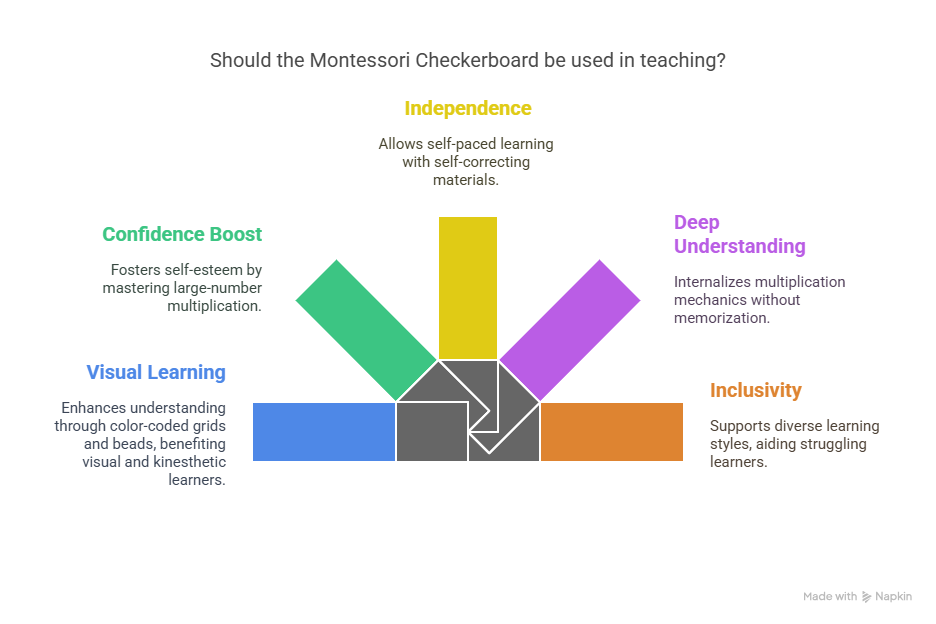Table of Contents
One of the major differences between traditional and Montessori schooling is the use of materials to help children in the learning process. A Montessori Checkerboard is one such material that helps students to connect with the numbers they are working rather than just seeing numbers on paper.
Montessori Checkerboard is an early elementary math material that is utilized to teach a variety of fundamental math concepts. The most popular use of this material is to teach multiplication. It makes learning multiplication fun by giving a strong visual of how the process works.
Register for the Entri Elevate Montessori Teacher Training Program! Click here to join!
How Does the Montessori Checkerboard Work?
-
Setup: The board is laid out with the green units square in the bottom right. Bead bars and number tiles are placed nearby.
-
Representing Numbers: The multiplicand (e.g., 34) is set along the bottom row using number tiles, and the multiplier (e.g., 2) along the right column.
-
Multiplication Process: The child places bead bars on the board to represent each multiplication step. For 34 x 2, they place two 4-bead bars in the units (green) square and two 3-bead bars in the tens (blue) square.
-
Summing Up: Beads are counted and exchanged (e.g., two 4-bead bars become one 8-bead bar) to find the final product, often recorded on paper.
-
Advancing Complexity: As skills grow, children tackle larger numbers, even into the billions, building confidence in long multiplication.
This method reinforces place value, skip counting, and multiplication facts through tactile exploration, making math a full-body experience.
How to Make a Montessori Checkerboard?
A Montessori checkerboard has four rows and nine columns of squares alternating in green, blue, and red colour. Traditionally, the checkerboard was made of wood, but now they are sewn using fabric, or one can also find printable checkerboards.
To make a checkerboard, you will need the following:
- Cardboard or wooden board for the base (10 inches wide and 18 inches long)
- Ruler and pencil
- Red, green and blue coloured paper or paint
- Multiplication beads or counters
Steps to Make the Checkerboard
- Take the cardboard or wooden board and draw squares of 1 inch each. There must be four rows of nine squares.
- The Montessori checkerboard follows a colour pattern that represents the place value. Use coloured paper or paint to fill each square. To know more about the colour pattern, read the details given below.
- Label the rows to indicate place values like ones, tens, hundreds etc.
- Prepare beads or counters in different colours.
Colour Patterns on a Montessori Checkerboard
The colours on a Montessori Checkerboard are green, blue and red. These colours alternate and repeat after every three squares. In a column,
- Green represents units
- Blue represents tens
- Red represents hundreds
The alternating colour pattern is repeated across the rows with the right bottom square being green. This is the starting point for numbers on this board. The individual horizontal rows not only represent place value but also represent the partial products of multiplication.
Using the bead bars helps children to practice skip counting and they are able to absorb things and put into their memory, rather than memorizing the multiplication facts. Montessori methods are useful as they help children to think organically and understand the underlying concept. Entri Elevate Montessori Teachers Training course helps teachers in the Montessori method of education. This course helps you attain the required qualification and achieve your dream job.
Register for the Entri Elevate Montessori Teacher Training Program! Click here to join!
Benefits of the Montessori Checkerboard
1: What is the primary focus of the first plane of development in the Montessori method?
-
Visual Learning: The color-coded grid and beads make abstract multiplication tangible, ideal for visual and kinesthetic learners.
-
Confidence Boost: Mastering large-number multiplication fosters self-esteem and motivates further exploration.
-
Independence: Self-correcting materials allow children to work at their own pace, aligning with Montessori’s child-directed approach.
-
Deep Understanding: By manipulating beads, students internalize multiplication mechanics without relying on memorization.
-
Inclusivity: The tactile nature supports diverse learning styles, helping struggling learners grasp concepts.
Get Certified & Start Your Montessori Career
Montessori Teacher Training Course by Entri App: Gain expert skills, earn certification, and kickstart your teaching career.
Join Now!Summary
The Montessori Checkerboard serves as a gateway to mathematical exploration. It enables children to visualize and create numbers into the billions while clearly demonstrating how multiplication can generate such large figures. This tool provides a hands-on experience for students, thanks to its substantial size. By using beads and number squares, students can reinforce and visualize the relationships between numbers. This approach helps ground their understanding of numbers and mathematical operations in a concrete and tangible experience, allowing them to progress to more abstract concepts at their own pace.
| Also Read | |
| Montessori Learning Materials | |
| Practical Life Tools Creation Project | |
| Montessori Pink Tower Making | |
| Knobbed Cylinders in Montessori | |
Get Certified & Start Your Montessori Career
Montessori Teacher Training Course by Entri App: Gain expert skills, earn certification, and kickstart your teaching career.
Join Now!Frequently Asked Questions
What is the purpose of Montessori checkerboard?
Montessori checkerboard helps children to connect with the numbers they are working rather than just seeing numbers on paper. The most popular use of this material is to teach multiplication.
What do the different colours on the checkerboard represent?
There are three colours on the checkerboard: green, blue and red.
- green represents units
- blue represents tens
- red represents hundreds
At what age is the Montessori Checkerboard introduced?
The Checkerboard is typically introduced in Montessori lower elementary, around ages 6–9, when children are ready for advanced multiplication. It builds on prior tools like the Golden Beads and Bead Cabinet, which teach place value and basic operations.
Why is the Montessori Checkerboard effective for learning multiplication?
The Checkerboard’s effectiveness lies in its hands-on, visual approach. Color-coded squares and bead bars make multiplication for kids tangible, helping visual and kinesthetic learners grasp place value and algorithms.
Can I use the Montessori Checkerboard at home?
Yes, the Montessori Checkerboard is perfect for homeschooling or supplementing learning. Parents can purchase or make a fabric Checkerboard and bead bars from retailers like Etsy or Montessori outlets.
How does the Montessori Checkerboard differ from traditional multiplication methods?
Unlike traditional methods relying on memorization or worksheets, the Checkerboard uses tactile and visual aids to teach long multiplication.
What skills does the Montessori Checkerboard teach?
The Checkerboard teaches multiplication for kids, place value, skip counting, and problem-solving. It also develops fine motor skills through bead manipulation, concentration through focused tasks, and independence via self-correcting materials.
How does the Montessori Checkerboard prepare kids for advanced math?
The Checkerboard bridges concrete and abstract math, preparing children for advanced concepts. By mastering long multiplication and place value, kids develop a strong number sense, crucial for division, fractions, and algebra.


